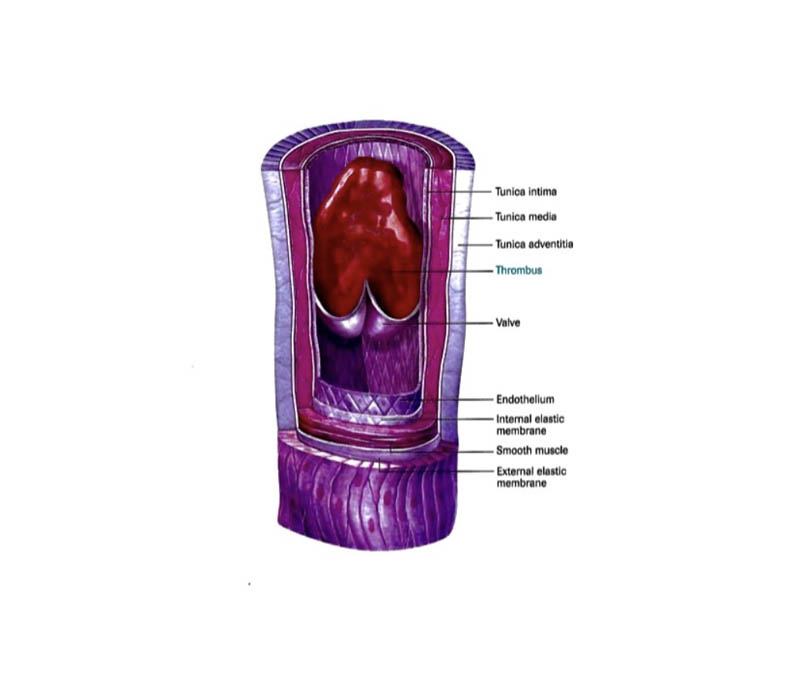By: Prof. Dr. Seyed Saeid Zamanieh Shahri, MD and Prof. Dr. Sonia Sayyedalhosseini, MD
DVT is a blood clot that forms in one of the deep veins of the body. This blood clot usually occurs in the legs and causes severe pain and swelling in the legs. Sometimes this blood clot can travel to a person’s lungs and cause a pulmonary embolism. The deep veins of the leg are larger veins that cover from the beginning of the leg to the thighs. These veins cannot be easily seen under the skin. They are also not like varicose veins. When a person has deep vein thrombosis, blood flow in the vessel is partially or completely blocked by a blood clot.
Leg veins are the most common site for deep vein thrombosis. The veins in the thighs are less likely to suffer from this complication. In rare cases, other deep blood vessels in the body may become blocked due to the formation of blood clots. Deep vein thrombosis is a member of a group of problems called venous thromboembolism. Blood clots in the vessels often occur in the legs, but can sometimes affect other areas of the body, including the arms. The most common cause of blood clots is sedentary lifestyle. In some cases, the blood clot may be caused by the breakdown of blood in other parts of the body and its spread to the lungs, which is called a pulmonary embolism.
This can usually be prevented by taking anticoagulants.
In other words pulmonary embolism occurs when a blood clot that forms in a deep vein ruptures and travels to the lungs and gets stuck in one of the blood vessels. Pulmonary embolism is also part of venous thromboembolism.
An embolism occurs when a thrombus comes out of its place and travels into the bloodstream to other parts of the body. The work then progresses to the point where the motile blood clot gets stuck in the narrower blood vessels, blocking the pathway. In this case, thrombosis is called embolism.
Causes of venous thrombosis:
Blood flows naturally in our vessels at a high rate and usually does not clot. Movements help improve blood flow to the vessels because muscle function causes the body’s vessels to constrict. Deep vein thrombosis sometimes occurs for no apparent reason. However, the following causes increase the risk of deep vein thrombosis.
– Intravenous tissue damage: Injury to the inner venous layer increases the risk of blood clots. Some conditions, such as inflammation of the vessel wall (vasculitis) and the use of certain medications, such as some chemotherapy drugs, can damage the vessel and increase the risk of deep vein thrombosis. It is also sometimes possible for vascular damage to be caused by needle injuries. Such injuries may occur in a hospital after drip treatment (a thin tube is inserted into a vein to drain body fluid). Also, the risk of venous injury and deep vein thrombosis is very high among drug users such as heroin. This is especially true if illegal drugs are injected into the leg or groin. Therefore, if a person has venous thrombosis, there is a possibility that he or she will develop it again in the future.
– Lack of movement: Lack of movement causes the speed of blood flow in the vessels to slow down. Blood clots are much more likely to form when the flow rate is slower than normal.
– Surgery in which a person is unconscious for about 1 to 5 hours or more is the most common cause of deep vein thrombosis. When a person is unconscious, in fact, his legs are completely immobile and his muscles are temporarily paralyzed. In this case, the blood flow in the veins of the leg is very slow and it is more likely to form a clot. Deep vein thrombosis is very likely to occur in certain types of surgery (especially pelvic or leg surgery).
– Any illness or injury that causes a person to become immobile increases the risk of developing a blood clot. Plastering the leg after a fracture is one of these cases. People who are admitted to the intensive care unit are also at risk for a variety of reasons; these people are not active and sometimes they may even fall asleep for a long time due to the injection of anesthetic drugs.
– Long journeys by plane, train or car may also increase the risk of deep vein thrombosis. Because in these situations people are often in a sitting position for a long time.
Risk factors for Deep Vein Thrombosis:
Conditions that make blood clotting easier than normal (thrombophilia) can increase the risk of deep vein thrombosis. Some conditions cause the blood to clot easily. Some of these include nephrotic syndrome and antiphospholipid syndrome. Some rare inherited and genetic conditions also play a role in blood clotting. An example of an inherited blood disorder is the Leiden factor 5 mutation.
If a person has a family history of deep vein thrombosis or at least one of their close relatives has the disease, it is very likely that the person will also get it. Other risk factors, in short, include hormone therapy with birth control pills, patches, rings, and estrogen replacement therapy, which make the blood more prone to clotting.
People with cancer or heart failure are at higher risk for developing deep vein thrombosis. Sometimes it occurs in a person who has not yet been diagnosed with cancer. Some researches showed that cancer can be a major cause of deep vein thrombosis.
Aging (over 60 years); Older people are more likely to develop deep vein thrombosis, especially if they are less active or have a serious illness such as cancer.
Pregnancy increases the risk of deep vein thrombosis. Approximately one in 1,000 pregnant women develops deep vein thrombosis during pregnancy or during the first six months after delivery.
If the body mass index is more than 30 kg / m, the risk of deep vein thrombosis is higher. Obesity increases the risk of deep vein thrombosis.
Dehydration can also cause deep vein thrombosis because the blood becomes stickier and more prone to clotting.
Signs and symptoms of deep vein thrombosis:
Deep vein thrombosis usually occurs in the deep vein below the knee and in the soft part of the leg. Symptoms of deep vein thrombosis generally include: Swelling of the foot, pain and tenderness in the leg, discoloration, and temperature of the leg. Blood that normally passes through a blocked vein travels to the external arteries, which can cause the leg to heat up as well as become red. Sometimes deep vein thrombosis may have no symptoms and can only be diagnosed if complications such as pulmonary embolism occur.
Diagnostic methods:
Sometimes it is difficult for a doctor to diagnose symptoms because there are other causes for leg pain and swelling.
Examples of conditions that can cause similar symptoms include a variety of skin (cellulite) or muscle infections.
Your doctor may use a Wells score to determine if you have deep vein thrombosis. This includes examining the symptoms and risk factors for deep vein thrombosis.
If a doctor suspects that a person has deep vein thrombosis, he or she is usually advised to have tests done immediately to confirm or deny the diagnosis. Two common tests in this area are:
Di-dimer blood test: This test detects small, broken pieces of blood clots. The higher the score on this test, the more likely it is that a blood clot will form in a vein. Unfortunately, sometimes the result of a dimer test can be positive in other situations, such as if the person has recently had surgery or is pregnant. Therefore, a positive test result does not necessarily indicate a deep vein thrombosis, but merely indicates the possibility of a blood clot forming and the need for further tests.
Also, a special type of ultrasound called Doppler ultrasound is used to show blood flow in the vessels of the legs and the presence of any obstruction in the blood flow. Doppler ultrasound is very useful because it is both very simple and non-invasive. Of course, sometimes these tests are not definitive and more accurate tests are needed.
Contrast Venography is another test that can be performed to complement these tests. In this test, a contrast substance is injected into the vessels of the leg to show the presence of blockages and blood clots. The condition of this contrast in the legs can then be seen with the help of X-ray graphy. In some cases, CT scans and MRIs are also used to diagnose deep vein thrombosis.
Sometimes, especially if it is not possible to scan for a while, daily injections may be given to lower the blood concentration.
Important Note: Although the symptoms of DVT gradually go away, there are still two possible side effects:
- Moving a blood clot to the lungs or pulmonary embolism.
- Stable symptoms and consequent post-thrombotic syndrome
Prevention of recurrence or disease: Other factors that may be effective in preventing deep vein thrombosis or its recurrence include the following:
Avoid staying still for long periods of time, such as sitting in a chair for long periods of time. In such cases, if you can, get up and take a few steps from time to time. Even if you can walk for 30 minutes a day, that’s much better.
The purpose of this is to prevent blood clots and improve blood circulation in the legs. Regular exercise of the leg muscles is also very effective in this regard. You can do some leg exercises even while sitting.
Major surgeries, especially pelvic, abdominal, and leg surgeries, are a risk factor for deep vein thrombosis. There are many ways to help reduce this risk, some of which include:
Using an inflatable pump to compress the legs during long surgeries is one of these options, called DVT pump.
Varicose socks may also sometimes be given to the patient to wear when hospitalized.
The most common thing is to get out of bed and walk as soon as possible after surgery.
When you are on a plane, train or car for a long time, you should get up from time to time and walk in its corridor.
Try to shake your calf muscles and exercise while sitting in a chair. In such cases, you can rotate your ankles, place them on your toes, or lift your toes off the floor while your heels are stuck on the floor of the hallway. Always try to stay hydrated and avoid alcohol and sleeping pills.
People who are overweight have a higher risk of developing deep vein thrombosis. Therefore, to reduce the risk of deep vein thrombosis, you should try to keep your weight balanced and proportionate.















